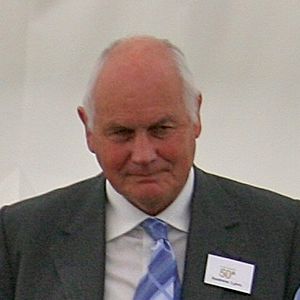Andrew Lyne facts for kids
Quick facts for kids
Andrew Lyne
|
|
|---|---|

Andrew Lyne in 2007
|
|
| Born |
Andrew Geoffrey Lyne
13 July 1942 |
| Education | The Portsmouth Grammar School |
| Alma mater |
|
| Awards | Herschel Medal (1992) |
| Scientific career | |
| Fields | Radio astronomy Pulsars |
| Institutions | Jodrell Bank Observatory University of Manchester University of Cambridge |
| Thesis | Interferometric Observations of Lunar Occulations and Pulsars (1970) |
| Doctoral advisor | Francis Graham-Smith |
| Doctoral students | Duncan Lorimer |
Andrew Geoffrey Lyne (born 13 July 1942) is a British physicist who studies space. He is a professor of Physics at the University of Manchester. He also used to be a director at the Jodrell Bank Observatory, which is a famous place for studying space.
Even though he retired in 2007, Andrew Lyne still actively researches pulsars. Pulsars are like cosmic lighthouses that spin very fast. He is especially interested in finding tiny, fast-spinning pulsars called millisecond pulsars. He also looks for young pulsars and those that orbit another star in a binary system.
Contents
Early Life and Learning
Andrew Lyne went to school at Portsmouth Grammar School in England. He also studied at the Royal Naval School in Malta. Later, he went to the University of Cambridge to study science. After that, he continued his studies at the University of Manchester. There, he earned his PhD in Radio astronomy. Radio astronomy is a way of studying objects in space by listening to the radio waves they send out. His research was guided by a scientist named Francis Graham-Smith.
Discovering Pulsars
Andrew Lyne has done a lot of important work in space science. He is known for his research on pulsars.
The Pulsar Planet Mystery
In 1991, Andrew Lyne and his colleague Matthew Bailes thought they had found something amazing. They believed they had discovered a pulsar with a planet orbiting it. This would have been the very first planet found around a star other than our Sun!
However, after they announced their discovery, they checked their work again. They realized they had made a small mistake. They had not properly removed the effects of Earth's movement around the Sun from their calculations. When they fixed this, the signs of the planet disappeared. It turned out there was no planet around that pulsar, called PSR 1829-10.
When Andrew Lyne announced that their first finding was incorrect, other scientists were very impressed. They applauded him loudly. It showed great honesty and courage to admit a mistake publicly.
A Special Double Pulsar
In 2003, Andrew Lyne and his team made another exciting discovery. They found the first-ever binary system where both objects were spinning neutron stars that send out pulses. Neutron stars are super dense objects left behind after a giant star explodes.
One of Lyne's colleagues, Richard Manchester, called this system (named PSR J0737-3039) a "fantastic natural laboratory." This is because it's a perfect place to study special effects of Einstein's General Theory of Relativity. This theory explains how gravity works and how massive objects affect space and time.
Andrew Lyne has also studied a group of stars called 47 Tucanae. This area has many stars packed together. It's a great place to find millisecond pulsars and pulsars that are part of binary systems.
Awards and Recognition
Andrew Lyne has received several honors for his work.
- In 1992, he was given the Herschel Medal by the Royal Astronomical Society.
- In 1996, he was chosen to be a Fellow of the Royal Society (FRS). This is a very high honor for scientists in the United Kingdom.

